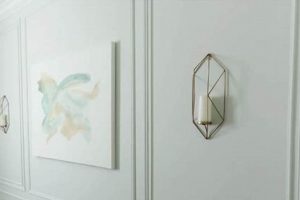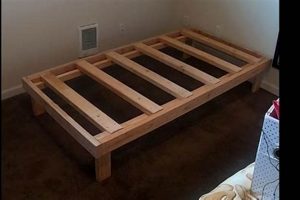The practice of crafting decorative borders for images using various materials and techniques is a popular form of do-it-yourself (DIY) projects. This encompasses selecting, cutting, joining, and finishing lengths of wood, plastic, or metal to create a visually appealing enclosure for artwork, photographs, or mirrors. For example, an individual might choose to purchase unfinished wood trim, miter the corners to precise angles, assemble the frame with glue and nails, and then stain or paint the finished piece to complement the displayed item.
Engaging in this creative endeavor offers numerous advantages. It provides a cost-effective alternative to purchasing ready-made frames, allowing for customization to match specific aesthetic preferences and dimensional requirements. Historically, ornate framing was a mark of status and wealth, used to accentuate the importance of the artwork. Today, this activity empowers individuals to express their personal style and enhance their living spaces while fostering a sense of accomplishment through hands-on creation. It also facilitates upcycling and repurposing of materials, contributing to sustainable practices.
The following sections will delve into specific aspects of this activity, including material selection, essential tools, step-by-step construction methods, and various finishing techniques to achieve professional-looking results. Consideration will be given to different styles, from simple and modern to ornate and traditional, enabling readers to tailor their projects to their individual tastes and project goals.
Essential Considerations for Quality Results
The following suggestions are designed to enhance the success rate and overall quality of crafting decorative borders for images and artwork. Adherence to these principles will contribute to a more professional and enduring final product.
Tip 1: Prioritize Accurate Measurements: Precise measurements are paramount. Double-check dimensions before cutting materials to prevent errors that can compromise the frame’s integrity. Utilize a high-quality measuring tape and a reliable angle finder for optimal accuracy.
Tip 2: Select Appropriate Materials: The choice of material should align with the intended aesthetic and the weight of the artwork. Lightweight materials like pine may suffice for smaller prints, while heavier artworks require sturdier options such as oak or maple.
Tip 3: Employ Miter Saw Precision: When employing a miter saw, ensure the blade is sharp and the angle is set accurately. A dull blade can result in splintering and an imprecise cut. Consider practicing on scrap material before cutting the final pieces.
Tip 4: Secure Joints with Strength: Utilize both wood glue and fasteners (nails or screws) to ensure robust joint construction. High-quality wood glue, properly applied, creates a bond stronger than the wood itself. Fasteners provide immediate support while the glue cures.
Tip 5: Sand Surfaces Thoroughly: Before applying any finish, meticulously sand all surfaces to create a smooth and uniform texture. Start with a coarser grit sandpaper and gradually progress to finer grits to achieve the desired smoothness.
Tip 6: Apply Finish Evenly: When staining or painting, apply the finish in thin, even coats. Multiple thin coats are preferable to a single thick coat, which can lead to runs, drips, and uneven coverage. Allow each coat to dry completely before applying the next.
Tip 7: Use Proper Safety Equipment: Eye protection and hearing protection are crucial. Always wear safety glasses when cutting and sanding. If using power tools for extended periods, hearing protection is recommended to prevent auditory damage.
Implementing these considerations ensures a higher likelihood of achieving a well-crafted, visually appealing, and structurally sound product. Diligence and attention to detail are key factors in elevating the outcome from a simple craft project to a professionally finished piece.
With a solid understanding of these fundamentals, the article will now shift to more advanced techniques and stylistic considerations.
1. Precise Miter Cuts
The accuracy of angled cuts is a foundational element in the successful construction of decorative borders for images. These angled cuts, typically 45 degrees for a rectangular frame, must converge seamlessly to form a cohesive, aesthetically pleasing corner. Imprecision in this area compromises the overall quality and appearance of the finished piece.
- Corner Alignment and Visual Harmony
Inaccurate miters result in gaps or overlaps at the corners, disrupting the frame’s clean lines. Visual harmony is essential for presenting artwork effectively. If the frame draws attention to its imperfections, it detracts from the framed object’s intended impact. A misalignment of even a fraction of a degree can become highly noticeable. Precise cuts enhance the frames visual appeal, allowing it to complement the artwork without distraction. For instance, a crooked corner on a minimalist frame design will be far more glaring than on a frame with ornate carvings.
- Structural Integrity and Long-Term Stability
Beyond aesthetics, precise miter cuts contribute to the structural integrity of the frame. Poorly joined corners weaken the entire structure, making it susceptible to breakage or warping over time. A tight, gap-free joint distributes stress evenly, preventing premature failure. Employing high-quality wood glue and fasteners in conjunction with accurate miters ensures that the frame can withstand environmental changes and the weight of the artwork. Examples include frames exposed to temperature fluctuations or those used to display heavy items like mirrors.
- Tool Selection and Technique Mastery
Achieving accurate miter cuts necessitates using appropriate tools and mastering the correct techniques. A miter saw, whether manual or powered, is essential for making consistent, angled cuts. Calibration of the saw and selection of a sharp blade are critical. Furthermore, the operator’s skill in aligning the molding accurately and applying consistent pressure influences the outcome. Experienced craftspeople often employ jigs and clamps to ensure repeatable accuracy. Novices should practice on scrap material to hone their skills before cutting the final pieces.
- Material Considerations and Adjustments
The type of material used affects the ease and accuracy of miter cuts. Softer woods like pine are more forgiving but can splinter if cut with a dull blade. Hardwoods require sharper blades and slower cutting speeds to prevent tear-out. Manufactured materials like MDF or polystyrene often produce cleaner cuts but may require specific blades designed for those materials. Additionally, slight adjustments to the miter angle may be necessary depending on the material’s thickness and density to achieve a perfect corner joint.
The interplay between accurate angled cuts and all elements used during borders crafting significantly influences the quality, stability, and overall aesthetic appeal. Attention to detail in this critical step elevates the final project from a simple craft to a professionally crafted piece.
2. Joint Strength
Joint strength is a critical determinant of longevity and structural integrity in decorative borders crafted for images. The capacity of the corner joints to withstand stress, tension, and environmental factors directly impacts the frame’s overall durability. Weak joints compromise the frame’s ability to securely hold the artwork and maintain its shape over time.
- Adhesive Selection and Application:
The choice of adhesive is paramount. High-quality wood glues designed for carpentry create bonds that exceed the wood’s inherent strength. Proper application techniques, including even distribution and adequate clamping pressure, maximize adhesion. For example, polyurethane adhesives offer superior water resistance, making them suitable for frames exposed to humidity. Conversely, cyanoacrylate adhesives (super glue) provide rapid bonding but lack long-term durability under stress.
- Mechanical Fasteners:
Mechanical fasteners supplement adhesive bonds, providing immediate reinforcement and long-term stability. Options include nails, screws, and specialized joint fasteners. The type and placement of fasteners must be carefully considered. For instance, brad nails offer minimal holding power but are suitable for delicate moldings, while screws provide superior strength but require pre-drilling to prevent splitting. Miter clamps, corner clamps, or band clamps are used to apply adequate pressure on the frame joints during the glue drying process to get the best result.
- Joint Design and Geometry:
The design of the joint itself influences its inherent strength. Miter joints, while aesthetically pleasing, are inherently weaker than interlocking joints. Reinforcing miter joints with splines, dowels, or metal fasteners increases their resistance to racking and shear forces. For example, a spline joint involves cutting a slot into the mitered faces and inserting a thin piece of wood, effectively increasing the gluing surface area.
- Material Compatibility:
The compatibility of materials used in frame construction affects joint integrity. Dissimilar materials with differing expansion and contraction rates can induce stress on the joints, leading to failure over time. For example, combining solid wood with MDF (Medium-Density Fiberboard) requires careful consideration of potential movement differences. Using appropriate adhesives and allowing for expansion gaps can mitigate these risks.
The interplay of adhesive selection, mechanical fastening, joint design, and material compatibility directly determines the robustness of decorative borders for images. Neglecting any of these facets can result in weakened joints, compromising the frame’s structural integrity and longevity. Consideration of these elements elevates the project from a mere craft to a durable and professionally finished piece.
3. Surface preparation
Surface preparation represents a critical phase in the creation of decorative borders for images, influencing the final aesthetic quality and longevity of the project. This stage encompasses a series of processes undertaken to ensure the material’s surface is receptive to finishes, adhesives, and other treatments. The effectiveness of these subsequent applications hinges directly on the thoroughness and precision of surface preparation. Failure to adequately prepare the surface invariably leads to compromised adhesion, uneven finishes, and ultimately, a reduction in the overall value and appearance of the finished piece. For instance, if a wood frame is not properly sanded, stain absorption will be inconsistent, resulting in blotchy coloration. In the context of working with metal, rust or mill scale left untreated will prevent paint from adhering, leading to premature peeling and corrosion.
The specific techniques involved in surface preparation vary depending on the material being used. For wood, sanding is essential to create a smooth, even surface and open the wood pores for stain penetration. This process often involves multiple grades of sandpaper, starting with a coarser grit to remove imperfections and progressing to finer grits for a polished finish. Filling any gaps or imperfections with wood filler ensures a uniform surface for subsequent treatments. Metal surfaces, conversely, may require cleaning with solvents to remove oils and contaminants, followed by abrasion with wire brushes or sanding to create a textured surface for paint adhesion. In some cases, chemical treatments such as etching or priming are necessary to promote optimal bonding. Plastic frames may require a light sanding or the application of a specialized primer to enable paint to adhere properly. The meticulous removal of dust and debris after each step is crucial to prevent surface contamination.
In summary, surface preparation constitutes an indispensable element in the creation of decorative borders for images. By meticulously attending to this stage, craftspeople can ensure the durability, aesthetic appeal, and long-term preservation of their work. While surface preparation can be time-consuming, the benefits of a flawlessly finished product far outweigh the effort expended. The commitment to thorough surface preparation signifies a dedication to quality and craftsmanship, elevating the project from a mere assembly of materials to a valuable and enduring piece of art.
4. Finish application
The final stage in crafting decorative borders for images involves applying a finish. This process protects the material, enhances its aesthetic qualities, and completes the transformation from raw components to a refined, display-ready item. The choice of finish, its method of application, and the adherence to best practices significantly influence the product’s visual appeal and long-term resilience.
- Protection and Preservation
Finishes provide a protective barrier against environmental factors such as moisture, UV radiation, and physical abrasion. For instance, a varnish or lacquer applied to a wooden frame shields the wood from humidity fluctuations, preventing warping and cracking. UV-resistant coatings safeguard against color fading, preserving the frame’s appearance and the artwork it contains. The protective layer created extends the life span of the frame, ensuring that it will safeguard and beautify the artwork for years to come.
- Aesthetic Enhancement
Finishes enhance the natural beauty of the material or introduce new visual characteristics. Stains highlight the grain pattern of wood, while paints offer a spectrum of colors to match any dcor. Textured finishes add depth and dimension, and specialized coatings can create effects such as metallic sheens or distressed patinas. The aesthetic properties of the finish should complement the artwork being framed, creating a unified and harmonious presentation.
- Application Methods and Techniques
The method of application impacts the uniformity and quality of the finish. Brushing, spraying, and wiping are common techniques, each suited to different types of finishes and project scales. Spraying typically yields the smoothest, most even coverage but requires specialized equipment and ventilation. Brushing is more accessible but demands careful technique to avoid brush marks. Wiping is ideal for applying stains and oils, allowing the finish to penetrate the material. Proper surface preparation, such as sanding and cleaning, is essential for achieving optimal adhesion and a flawless final result.
- Material Compatibility and Finish Selection
The choice of finish must align with the material of the frame. Water-based finishes are generally suitable for wood and some plastics, while solvent-based finishes offer greater durability but may damage certain materials. Metal frames require specialized coatings that prevent corrosion and adhere to the metal surface. Compatibility between the finish and the adhesive used in frame construction is also important to prevent chemical reactions or weakening of the joints. Selecting the correct finish ensures not only aesthetic appeal but also the structural integrity of the completed frame.
The application of a finish encapsulates the culmination of the border crafting process, adding a final layer of protection and refinement. The convergence of preservation, visual aesthetics, application methods, and material compatibility transforms unfinished pieces into aesthetically pleasing, long-lasting frames that enhance and protect the artwork they contain.
5. Material selection
Material selection is a foundational element in the success of decorative border construction projects. The choice of material dictates the aesthetic qualities, structural integrity, and overall longevity of the final product. Within the context of creating decorative borders for images, the interplay between material properties and the desired outcome is paramount. For instance, utilizing softwoods like pine offers ease of workability and affordability but may compromise durability and necessitate careful handling to prevent dents or scratches. Conversely, hardwoods such as oak or maple provide enhanced strength and resistance to wear but demand greater skill and specialized tools for precise cutting and shaping. The material’s weight also factors significantly, particularly when framing large or heavy artwork, as insufficient structural support may lead to warping or joint failure.
Practical considerations further highlight the significance of appropriate material selection. Consider the visual style of the artwork being framed; a rustic painting may be best complemented by a frame constructed from reclaimed wood, while a modern print might necessitate sleek, minimalist frames crafted from aluminum or acrylic. The environmental conditions to which the frame will be exposed also influence material choice. For humid environments, moisture-resistant materials such as treated wood or synthetic composites are preferable to prevent warping or fungal growth. The selected finish, whether paint, stain, or varnish, must also be compatible with the chosen material to ensure proper adhesion and a professional-looking result. For example, certain solvent-based finishes may damage or dissolve plastic frames, while water-based finishes may not adequately adhere to oily hardwoods without proper preparation.
In summary, informed material selection is indispensable for achieving high-quality, durable, and aesthetically pleasing decorative borders for images. The attributes of the chosen material directly influence the ease of construction, the long-term performance of the frame, and its ability to effectively complement and protect the artwork it encloses. The challenges associated with material selection underscore the importance of careful planning, thorough research, and a clear understanding of the project’s specific requirements and constraints. Attention to detail in material selection ensures that the final frame is not only visually appealing but also structurally sound and appropriately suited to its intended purpose.
6. Design considerations
Design considerations represent a pivotal aspect of decorative border construction for images, impacting both the aesthetic appeal and functional effectiveness of the finished product. Thoughtful design choices ensure the frame complements the artwork, integrates with the surrounding environment, and fulfills its intended purpose of protection and display. The interplay between form and function dictates the overall success of the endeavor.
- Profile Selection and Visual Harmony
The profile of the molding significantly influences the frame’s visual impact. A simple, flat profile minimizes distraction, allowing the artwork to take center stage, while an ornate, sculpted profile adds visual interest and complements more traditional pieces. The chosen profile should align with the artwork’s style, color palette, and overall aesthetic, creating a sense of visual harmony. For instance, a contemporary photograph might benefit from a sleek, minimalist frame, while a classic oil painting could be enhanced by a more elaborate, gilded design.
- Color and Finish Coordination
The color and finish of the frame must complement the artwork and the surrounding dcor. A neutral-colored frame provides versatility, blending seamlessly with various color schemes, while a bolder color can create a striking contrast or echo specific tones within the artwork. The finish, whether matte, glossy, or textured, influences the frame’s light reflectivity and overall visual texture. Coordinating the frame’s color and finish with the artwork and the room’s aesthetic creates a cohesive and visually appealing display.
- Scale and Proportion Balance
The frame’s size and proportion relative to the artwork are crucial for creating visual balance. A frame that is too small can appear insignificant, while one that is too large can overwhelm the artwork. The width of the molding should be proportional to the size of the artwork, creating a sense of visual equilibrium. Careful consideration of scale and proportion ensures that the frame enhances rather than detracts from the artwork’s impact.
- Material Compatibility and Durability
The choice of material should align with the frame’s intended use and environment. For high-humidity environments, moisture-resistant materials such as treated wood or synthetic composites are preferable to prevent warping or damage. The material’s durability should also be considered, particularly when framing valuable or fragile artwork. Selecting materials that are both aesthetically pleasing and structurally sound ensures the frame will protect and enhance the artwork for years to come.
These design considerations, encompassing profile selection, color and finish coordination, scale and proportion balance, and material compatibility, collectively define the aesthetic and functional characteristics of decorative borders. Thoughtful integration of these elements results in a frame that elevates the artwork, complements the environment, and stands the test of time.
7. Accurate measurement
Accurate measurement forms the cornerstone of successful decorative border construction projects. Its importance stems from the inherent precision required to create tightly joined corners and properly sized enclosures. Inaccurate measurements directly precipitate a cascade of negative effects, including misaligned corners, structural weaknesses, and overall aesthetic deficiencies. A failure to measure correctly, even by a small margin, can result in frames that are not square, that fail to properly hold the artwork, or that simply appear unprofessional. The cause-and-effect relationship is undeniable: precise measurements yield professional results, while imprecise measurements lead to flawed outcomes. This aspect cannot be overstated, as it sets the stage for all subsequent steps in the process.
The practical implications of this principle are readily apparent in the process. Consider a scenario where the intended dimensions for a frame are 12 inches by 16 inches. If each piece of molding is cut even one-eighth of an inch too long, the resulting frame will be noticeably oversized and the corners may not align properly. Furthermore, discrepancies in measurement can lead to uneven pressure distribution across the joints, increasing the risk of joint failure over time. The correct execution of this principle involves utilizing high-quality measuring tools, double-checking all dimensions, and accounting for the blade thickness when making cuts. By ensuring accuracy at the outset, craftspeople minimize the potential for errors later in the process, thereby streamlining construction and reducing material waste.
In summary, accurate measurement is not merely a preliminary step but a fundamental component that dictates the ultimate quality and structural integrity of decorative borders. The challenges associated with neglecting precise measurements manifest as visual imperfections, structural instabilities, and a diminished overall value. By embracing accuracy as a guiding principle, individuals ensure that their decorative border projects achieve professional standards and effectively enhance the artwork they are intended to showcase.
Frequently Asked Questions
This section addresses common inquiries and concerns regarding the practice of constructing decorative borders for images. The information provided aims to clarify key aspects and offer guidance based on established best practices.
Question 1: What is the optimal angle for miter cuts when creating a four-sided rectangular frame?
The generally accepted angle for miter cuts in this scenario is 45 degrees. This angle, when applied to all four corners, ensures that the frame’s corners form precise 90-degree angles, resulting in a square or rectangular shape.
Question 2: What type of adhesive is most suitable for joining wooden frame components?
Polyvinyl acetate (PVA) wood glue is generally recommended for its strong bonding capabilities and ease of use. For applications requiring enhanced water resistance, polyurethane-based adhesives offer a viable alternative.
Question 3: How can surface imperfections on wood molding be effectively addressed prior to finishing?
Sanding with progressively finer grits of sandpaper is the standard method for smoothing wood surfaces. Wood filler may be applied to fill gaps or imperfections, followed by additional sanding to ensure a uniform surface.
Question 4: What safety precautions should be observed when operating power tools for cutting molding?
Eye protection, in the form of safety glasses or goggles, is mandatory to prevent debris from entering the eyes. Hearing protection, such as earplugs or earmuffs, is advisable to mitigate noise-induced hearing damage. Ensuring adequate ventilation is critical to minimize exposure to dust and fumes.
Question 5: How does one prevent tear-out or splintering when cutting molding, particularly with a miter saw?
Employing a sharp blade specifically designed for fine cuts is crucial. Additionally, using a sacrificial fence or backing board can provide support and reduce the likelihood of splintering. Cutting slowly and steadily, rather than forcing the material, also minimizes tear-out.
Question 6: What factors influence the selection of a finish for a decorative border?
The material of the frame, the desired aesthetic, and the intended environment all influence finish selection. Water-based finishes are often suitable for wood and offer low VOC emissions, while solvent-based finishes provide enhanced durability. The selected finish must also be compatible with any adhesive used in the frame’s construction.
Accurate information and adherence to recommended practices are crucial for successful completion. These practices will facilitate a smooth progression from initial concept to finished product.
The next section will explore more advanced techniques and stylistic considerations to further enhance decorative border creation skills.
Concluding Remarks on Picture Frame Molding DIY
The preceding exploration of picture frame molding diy has underscored the critical elements involved in this craft. Precise measurement, material selection, joint strength, surface preparation, finish application, and thoughtful design considerations have all been identified as essential for achieving high-quality, durable results. Adherence to these principles ensures that the final product not only aesthetically complements the artwork it contains but also stands the test of time.
The decision to undertake picture frame molding diy represents a commitment to both aesthetic enhancement and practical skill. Continued refinement of these skills, coupled with a dedication to quality, will enable individuals to create lasting, personalized pieces that elevate the presentation of cherished images and artwork. The pursuit of excellence in this craft remains a rewarding endeavor, transforming raw materials into enduring objects of beauty and value.


![Build a Strong DIY Boxing Bag Frame [Project Guide] The DIY Hub: Creative Crafts, Repairs & Life Hacks Build a Strong DIY Boxing Bag Frame [Project Guide] | The DIY Hub: Creative Crafts, Repairs & Life Hacks](https://craftingdiycenter.com/wp-content/uploads/2025/07/th-2040-300x200.jpg)




